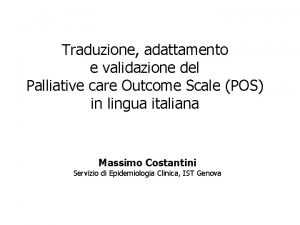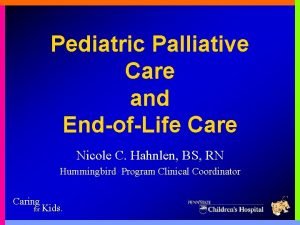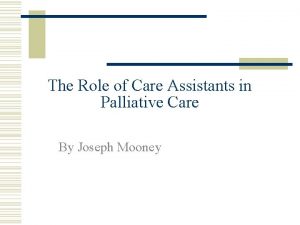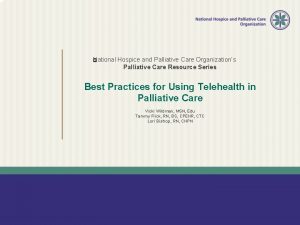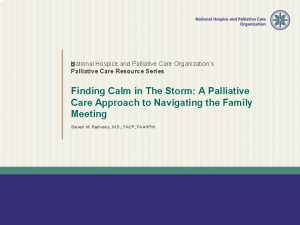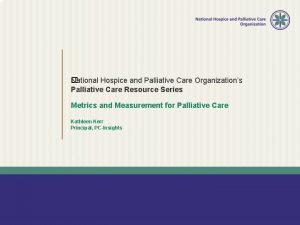National Hospice and Palliative Care Organizations Palliative Care














- Slides: 14

National � Hospice and Palliative Care Organization’s Palliative Care Resource Series Understanding the Importance of the Interdisciplinary Team in Pediatric Hospice and Palliative Care Kathleen Davis, Ph. D Associate Professor of Pediatrics University of Kansas Medical Center

OBJECTIVES q Define the IDT in hospice and palliative care q Understand the IDT describing the components and challenges q Describe the role of the IDT in pediatric hospice and palliative care

Understanding the IDT and Hospice and Palliative Care q Core element of hospice and palliative care q Many different disciplines make up the IDT q Additional disciplines needed for the pediatric patient q Child life q Art and music q Occupational, physical, language/speech therapists q Teachers q Lactation consultants q Others

Understanding the IDT – Multidisciplinary vs Interdisciplinary q Multidisciplinary and Interdisciplinary often used interchangeably when describing types of hospice and palliative care teams. q Multidisciplinary q q utilizes the skills and experience of individuals from different disciplines ensures each discipline approaches the patient from its own perspective involves separate individual consultations meets regularly, in the absence of the patient, to discuss future directions for the patient’s care q provides more knowledge and experience than disciplines operating in isolation

Understanding the IDT – Multidisciplinary vs Interdisciplinary q integrates separate discipline approaches into a single consultation. q. The patient-history taking, assessment, diagnosis, intervention and short- and long-term management goals are conducted by the team, together with the patient, and at one time. q The patient is intimately involved in any discussions regarding their condition or prognosis and the plans about their care. A common understanding and holistic view of all aspects of the patient’s care ensues (Jessup 2007).

Defining the IDT q Drinka and Clark’s (2000): q diverse training and education of team members q importance of collaboration q complexity of patient needs and problems q importance of members’ ability to agree upon their overall mission and develop shared goals q team’s acceptance and utilization of individual team members’ differences and power differentials q opportunity for overlapping roles to clarify the team’s growth and development

Components of IDT q A leader who establishes a clear direction and vision for the team, while listening and providing support/supervision. q Incorporates a set of values that clearly provide direction for the team’s service provision. q Demonstrates a team culture and interdisciplinary atmosphere of trust where contributions are valued and consensus is fostered. q Ensures appropriate processes and infrastructures are in place to uphold the vision of the service. q Provides quality patient-focused services with documented outcomes; utilizes feedback to improve the quality of care.

Components of IDT q Utilizes communication strategies that promote intra-team communication, collaborative decision-making, and effective team processes. q Provides sufficient team staffing to integrate an appropriate mix of skills, competencies, and personalities to meet the needs of patients and enhance smooth functioning. q Facilitates recruitment of staff who demonstrate interdisciplinary competencies including team functioning, collaborative leadership, and communication. q Promotes role interdependence while respecting individual roles and autonomy. q Facilitates personal development through appropriate training, rewards, recognition, and opportunities for career development. (Nancarrow 2013).

Challenges of IDT q lack of knowledge of the expertise of other professions q lack of commitment to the team process q lack of willingness to take on an equal share of the team’s work q IDT members’ lack of understanding of one another’s expertise q role blurring q theoretical differences q power differentials on the team q scapegoating q client stereotyping q value based conflicts between different professions q negative team norms q administrative issues

Pediatric Palliative Care and Hospice and the IDT The palliative care and/or hospice interdisciplinary team provides family centered care that includes the child and family as one unit of care, respecting individual preferences, values and cultural beliefs, with the child and family active in decision making regarding goals and plan of care” (NHPCO, 2009).

Pediatric Palliative Care and Hospice and the IDT q Enhance the quality of life for all involved, in large part by preventing and alleviating suffering using the skills and knowledge of a specialized care team that includes doctors, nurses, social workers, chaplains, child life therapists, and others. q Focuses on pain and symptom management, information sharing and advance care planning, practical, psychosocial and spiritual support, and coordination of care. (AAP, 2015).

Pediatric Palliative Care and Hospice and the IDT q The IDT may even extend beyond the health care professionals involved with the child and family. q Teachers, coaches, youth pastors, scout leaders, dance teachers and a host of other caring adults who are involved in the child’s life may also contribute. q Utilizing the expertise of a wide range of providers ensures that there is always someone who is available to attend to the challenging and ever-changing needs of the child and family.

Pediatric Palliative Care and Hospice and the IDT q There continues to be a lack of data to define achievements of pediatric providers and programs. q Consensus has not been reached within the pediatric palliative care field to standardize the methods of defining, measuring and analyzing effectiveness of providers and programs and barriers have been identified to achieving standardization (Kaye, Abramson, et al. 2017). q Developing metrics to effectively measure productivity of professionals and programs is critical to ensuring that the IDT is achieving recommendations of the AAP and providing optimal care to children and families.

Conclusion • The expertise, experience and compassion of the IDT is of utmost importance a child and family. • Honest, on-going communication among team members, and between the team and family receiving care, creates the foundation for the development of the IDT. • Combining a clear understanding of what an IDT is, and recognizing ways that each member may increase the knowledge and expertise needed to be the best IDT member possible are all strong pathways to being part of the IDT solution.
 Palliative care versus hospice care
Palliative care versus hospice care Franciscan palliative care
Franciscan palliative care National palliative care research center
National palliative care research center Hospice of the bluegrass frankfort ky
Hospice of the bluegrass frankfort ky Outcome measures traduzione
Outcome measures traduzione Difference between metoclopramide and domperidone
Difference between metoclopramide and domperidone Esasr
Esasr Rug adl score
Rug adl score Tarek mahdi md
Tarek mahdi md Principles of palliative care
Principles of palliative care Palliative care in nepal
Palliative care in nepal Palliative care assistant
Palliative care assistant European certificate in essential palliative care
European certificate in essential palliative care Parallel planning palliative care
Parallel planning palliative care Sas assessment tool
Sas assessment tool




